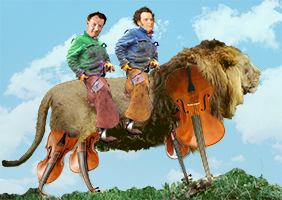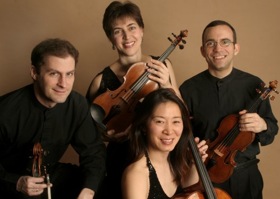
with the startling bodily integrity
of a single beast
Illustration by Jeff Dunn
If that kind of distinctiveness is the touchstone of great ensemble playing (as I believe), then the Brentano Quartet has been a great string quartet for many years. Every time I hear this ensemble (which is rarely enough, though naturally as often as I can), there it is: a true, consistent character. It has something definite to say, and it says it in a voice you can recognize at once, whether it be speaking Wuorinen and Schoenberg (as it did on the Brentanos’ last visit) or Schubert and Britten, as it did Sunday afternoon at Berkeley’s Hertz Hall. Cal Performances — which sponsored this recital, as it has two previous visits here — has the agreeable habit, not ubiquitous among presenters, of holding onto a good thing once it finds one. I trust that the Brentanos will be back, in the persons of violinists Mark Steinberg and Serena Canin, violist Misha Amory, and cellist Nina Maria Lee.
It’s difficult to describe the sense of concentration — not so much of mental attention (though of course there’s that, too) as of palpable density — in the quartet’s playing. It is at once extremely powerful and minutely controlled. You have the impression of enormous vitality and energy, though constrained by a kind of muscular discipline that makes the quartet’s every collective action intensely purposeful. There’s nothing diffuse or haphazard; every plane in the music’s shape is cleanly and decisively cloven, as though carved with a very sharp blade through very hard wood.
That quality made for an extraordinary performance Sunday of Benjamin Britten’s Third Quartet. Each of the music’s strange and particular textures was vivid in the Brentanos’ hands. Paired lines darted through the first-movement “Duets” like schooling fish. The slow, precarious violin line of the third-movement “Solo” trembled high over the abyss, breaking into birdlike ecstasy at the summit of the movement’s vertiginous arc. The two scherzos, the second and fourth movements, were drawn with ruthless, slashing strokes; the second strode and the third spun with demented energy, motoric yet disquietingly alive.
And everywhere there was that minutely focused, almost alarming sense of alertness to line and to color. The Brentanos’ lines are long and unerringly shaped, and their colors are intense without being brash. Momentary hues in the Britten — things like the outburst of chaotic joy in the “Solo,” or the luminous haze of harmonics at the end of the same movement, the grotesque tappings and raspings of the fourth movement’s Trio section, the bright harshness of sul ponticello at the beginning of the finale — were singular, immediate, sharply particular.
The work’s finale and its heart — that mysterious, ineffably calm passacaglia that Britten called “La Serenissima” — unfolded in steady measure, line overlaying line with infinite patience, and the whole suffused with the Brentanos’ lustrous, dark timbres. It was spellbinding playing.
Audaciously Powerful Playing
The Franz Schubert quartets surrounding the Britten were as impressive. In the program-opening Quartettsatz (D. 703), it was again the combination of power and control that made the greatest impression. Like the Mendelssohn F-Minor Quartet that the ensemble brought on a previous Bay Area visit, the Quartettsatz bristles with fast, doubled notes. The temptation, as with the Mendelssohn, is to let the music’s prevailing tone of anxiety-bordering-on-panic overwhelm everything else in the piece. The Schubert, being a lot shorter, bears that kind of thing rather better than the Mendelssohn does, but it was nonetheless remarkable how different from its usual blustery self it seemed in the Brentanos’ hands. The audacious precision and clarity of the playing seemed to amplify it.
Photo by Peter Schaaf
And the quartet moved with uncanny unanimity of mind. The supple line pulled back and pressed forward with the startling bodily integrity of a single beast — turning, pausing, dashing ahead, suddenly rearing up. I’ve never been quite happy with the ideal of the quartet-as-hive-mind, having heard ensembles refine themselves into blindingly perfect blanks in pursuit of it. But what the Brentanos do is something beyond exceptional blend, balance, intonation, and ensemble; they seem to act in concert like the muscles of a limb, pulling in various directions yet with a single intent, accomplished in a single gesture.
If any work demands that sort of singleness of purpose, it’s Schubert’s great G-Major Quartet, D. 887. This is not — not quite — the longest of the composer’s chamber works, but it’s by some ways the most arduous and the most daunting. It’s not just the scale (the first movement alone is 23 minutes or so long, with the repeat), nor the technical difficulties (though they are extreme), but the profoundly disorienting character of the thing that makes the work so challenging. In the last few years of his short life, Schubert grew increasingly interested in new paths from key to key and new ways of juxtaposing keys. In the G-Major Quartet he built a beautiful though harrowing labyrinth out of those experiments.
The piece has moments of extraordinary serenity in it, but there are doors opening from these places in all directions, and you never know which the composer will choose. Some sequences shift kaleidoscopically through remote keys, stopping seemingly at whim and letting the music restart from there. Brusque jolts are heard from major to minor key (like the opening of the first movement) and back (like the opening of the last). For that matter, at certain points part of the quartet insists on a modulation while part strenuously fights it. Every place of repose turns out to be contingent, or harried, or compromised, or illusory; and when in the end, with a final lunge, the last movement wrenches free of yet another slippery key-cascade and dances itself off the stage, it feels almost as though the players have coerced an ending by main force.
Making sense of all that — by which I mean, among other things, making non-sense of it, heightening the elements of centerlessness, unreason, ambiguity, and fear that are so big a part of the music — takes a long perspective and an uncommonly reliable compass. You have to know where you are, where you are going, and (crucially) where you might have gone instead.
Never Lost in the Labyrinth
The Brentano Quartet had, above all, a sure understanding of the work’s architecture, a well-annotated map of the labyrinth. You could tell by the way they extricated themselves from those disorienting rotations through key after key: The final lunge, the one that took the music out of the cascade into some sort of stability, was the one where the quartet seemed for a moment to be playing near its breaking point. Near the end of the first movement’s development, and again near the end of the finale, it was as though quartet and composer, at the same point, felt “This can’t go on,” and ripped free. Full though the performance was of momentary marvels — little miracles of timbre or phrasing or balance that caught the listener’s breath — nothing was more impressive than that feeling that somehow the Brentanos had compassed the piece whole.I should add that Misha Amory and Mark Steinberg contributed the program notes, and that they (particularly Steinberg’s on D. 887) shed light on the music in a way that program notes seldom do. (They are accessible, in PDF format, here.)

